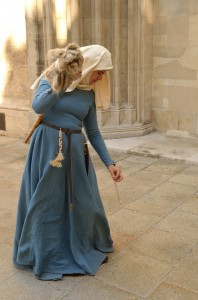Spinning
The principle of spinning is very easily explained since it only involves twisting animal or plant fibres in order to receive a longer string of fibres. Spinning goes hand in hand with weaving.
The tool of the spinner is the spindle, a thin staff with the so called spindle whorl attatched, a small weight that keeps the spindle turning longer. The spinner pulls the fibres from his hand or a distaff and adds it to the string.
Before the tread is ready to use, it has to be intertwined with a second string to make it persistant.
Any fibre can be spun which is not too short or flat. In medieval times, mainly linnen, wool and silk fibre were used, but also nettle and at times cotton (depending on the source either as a luxury or minor quality product).
Around 1350, most spinning is done with the handspindle although first depictions of the hand-stired spinning wheel (Luttrell Psalter) appear at the end of the 13th century, which does unfortunately not facilitate the spinning process much. Only the footpedal-stired spinning wheel – invented in the 15 century and long time demonized by the spinners guilds – revolutionises the process of spinning for a whole new future of textile production






